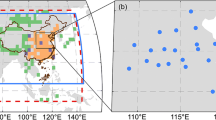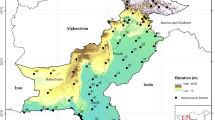Abstract
This study was aimed at evaluating the application of the canonical correlation analysis (CCA) to predict monthly precipitation amounts (predictands) by benefitting from 17 large-scale climate indices (predictors) in Iran. Monthly precipitation data, covering the period of 1987–2017, were collected from 100 weather stations across the country. Monthly precipitations were predicted using the multiple linear regression (MLR) models, based on the 1- to 6-month lead times of the original and canonical predictors. The cross-validation was conducted to compare the prediction skills of the two sets of MLR models constructed on the basis of the original predictors (MLOrigPr) and the canonical predictors (MLCCAPr). The analyses revealed the dominant teleconnections and that there are the interannual variations in responses of precipitation to them suggesting that a signal only is not sufficient to achieve a robust understanding of the associations. At the 1-month lead time, the MLR models based on the canonical predictors outperformed those based on the original predictors. However, the skill of both models was reduced by increasing the lead times up to 6 months. Averaging on all stations, around 61.4% and 26.3% of the observed values, falls into the cross-validated 95% prediction intervals of the MLCCAPr and MLOrigPr models, respectively. Furthermore, the MLCCAPr models were found to be more spatially universal than the MLOrigPr ones and decrease multicollinearity symptoms strengthening the predictions. These findings corroborated the advantage of using the CCA in improving the teleconnective predictability of precipitation in Iran.















Similar content being viewed by others
Data availability
Some or all data, models, or codes that support the findings of this study are available from the corresponding author upon reasonable request.
References
Ahmadi M, Salimi S, Hosseini SA, Poorantiyosh H, Bayat A (2019) Iran’s precipitation analysis using synoptic modeling of major teleconnection forces (MTF). Dyn Atmos Oceans 85:41–56
Alizadeh-Choobari O, Adibi P, Irannejad P (2018) Impact of the El Niño-Southern Oscillation on the climate of Iran using ERA-Interim data. Clim Dyn 51:2897–2911. https://doi.org/10.1007/s00382-017-4055-5
Araghi A, Mousavi-Baygi M, Adamowskib J, Martinez C (2017) Association between three prominent climatic teleconnections and precipitation in Iran using wavelet coherence. Int J Climatol 37:2809–2830
Asong ZE, Khaliq MN, Wheater HS (2016) Multisite multivariate modeling of daily precipitation and temperature in the Canadian Prairie Provinces using generalized linear models. Clim Dyn 47:2901–2921. https://doi.org/10.1007/s00382-016-3004-z
Assani AA, Guerfi N (2017) Analysis of the joint link between extreme temperatures, precipitation and climate indices in winter in the three hydroclimate regions of Southern Quebec. Atmosphere 8(75):1–13. https://doi.org/10.3390/atmos8040075
Barlow M, Zaitchik B, Paz S, Black E, Evans J, Hoell A (2016) A review of drought in the Middle East and Southwest Asia. J Climate 29:8547–8574. https://doi.org/10.1175/JCLI-D-13-00692.1
Barnett TP, Preisendorfer R (1987) Origins and levels of monthly and seasonal forecast skill for United States surface air temperatures determined by canonical correlation analysis. Mon Weather Rev 115(9):1825–1850
Barnston AG (1994) Linear statistical short-term climate predictive skill in the Northern Hemisphere. J Clim 7:1513–1564
Barnston AG, Ropelewski CF (1992) Prediction of ENSO episodes using canonical correlation analysis. J Clim 5(11):1316–1345. https://doi.org/10.1175/1520-0442(1992)005%3c1316:POEEUC%3e2.0.CO;2
Benestad RE (2002a) Empirically downscaled multimodel ensemble temperature and precipitation scenarios for Norway. J Climate 15:3008–3027
Benestad RE (2002b) Empirically downscaled temperature scenarios for northern Europe based on a multi-model ensemble. Climate Res 21:105–125
Casanueva A, Rodríguez-Puebla C, Frías MD, González-Reviriego N (2014) Variability of extreme precipitation over Europe and its relationships with teleconnection patterns. Hydrol Earth Syst Sci 18:709–725
Chan JY-L, Leow SMH, Bea KT, Cheng WK, Phoong SW, Hong Z-W, Chen Y-L (2022) Mitigating the multicollinearity problem and its machine learning approach: a review. Mathematics 2022(10):1283. https://doi.org/10.3390/math10081283
Dan W, Zhihong J, Tingting M (2016) Projection of summer precipitation over the Yangtze-Huaihe River basin using multimodel statistical downscaling based on canonical correlation analysis. J Meteor Res 30(6):867–880. https://doi.org/10.1007/s13351-016-6030-1
Dezfuli AK, Karamouz M, Araghinejad S (2010) On the relationship of regional meteorological drought with SOI and NAO over southwest Iran. Theoret Appl Climatol 100:57–66
Draper N, Smith H (1981) Applied regression analysis, 2d edn. John Wiley & Sons Inc, New York
Duzenli E, Tabari H, Willems P, Yilmaz MT (2018) Decadal variability analysis of extreme precipitation in Turkey and its relationship with teleconnection patterns. Hydrological Processes 1–16https://doi.org/10.1002/hyp.13275
Ghamghami M, Irannejad P (2019) An analysis of droughts in Iran during 1988–2017. SN Appl Sci 1:1217. https://doi.org/10.1007/s42452-019-1258-x
Ghamghami M, Ghahreman N, Olya H, Ghasdi T (2019) Comparison of three multi-site models in stochastic reconstruction of winter daily rainfall over Iran. Model Earth Syst Environ 5:1319–1332. https://doi.org/10.1007/s40808-019-00599-7
Ghasemi AR, Khalili D (2006) The influence of the Arctic oscillation on winter temperatures in Iran. Theoret Appl Climatol 85:149–164
Ghasemi AR, Khalili D (2008) The association between regional and global atmospheric patterns and winter precipitation in Iran. Atmos Res 88:116–133
Han LQ, Li SL, Liu N (2014) An approach for improving short-term prediction of summer rainfall over North China by decomposing interannual and decadal variability. Adv Atmos Sci 31:435–448. https://doi.org/10.1007/s00376-013-3016-0
Hosseinzadeh Talaee P, Tabari H, Ardakani SS (2012) Hydrological drought in the west of Iran and possible association with large-scale atmospheric circulation patterns. Hydrol Process 28(3):764–773. https://doi.org/10.1002/hyp.9586
Hotelling H (1936) Relations between two sets of variates. Biometrika 28:321–377
Hubert M, Vandervieren E (2008) An adjusted boxplot for skewed distributions. Comput Stat Data Anal 52(12):5186–5201. https://doi.org/10.1016/j.csda.2007.11.008
Hurrell JW (1996) Influence of variation in extratropical wintertime teleconnections on Northern Hemisphere temperature. Geophys Res Lett 23:665–668
Irannezhad M, Chen D, Moradkhani KB, H, (2017) Analysing the variability and trends of precipitation extremes in Finland and their connection to atmospheric circulation patterns. Int J Climatol 37:1053–1066
Khoshravesh M, Sefidkouhi MAG, Valipour M (2015) Estimation of reference evapotranspiration using multivariate fractional polynomial, Bayesian regression, and robust regression models in three arid environments. Appl Water Sci 7:1911–1922
Kim T, Shin JY, Kim S, Heo JH (2018) Identification of relationships between climate indices and long-term precipitation in South Korea using ensemble empirical mode decomposition. J Hydrol 557:726–739
Landman WA, Mason SJ (1999) Operational long-lead prediction of South African rainfall using canonical correlation analysis. Int J Climatol 19:1073–1090
Lima CHR, AghaKouchak A (2017) Droughts in Amazonia: spatiotemporal variability, teleconnections, and seasonal predictions. Water Resour Res 53(10):824–840. https://doi.org/10.1002/2016WR020086
Liu N, Li SL (2014) Predicting summer rainfall over the Yangtze-Huai region based on time-scale decomposition statistical downscaling. Wea Forecasting 29:162–176
Marcella MP, Eltahir EAB (2008) The hydroclimatology of Kuwait: explaining the variability of rainfall at seasonal and interannual time scales. J Hydrometeorol 9(5):1095–1105
Marzban C, Sandgathe S, Doyle JD (2014) Model tuning with canonical correlation analysis. Mon Wea Rev 142:2018–2027. https://doi.org/10.1175/MWR-D-13-00245.1
Molavi-Arabshahi M, Arpe K, Leroy SAG (2016) Precipitation and temperature of the southwest Caspian Sea region during the last 55 years: their trends and teleconnections with large-scale atmospheric phenomena. Int J Climatol 36:2156–2172
National Center for Atmospheric Research Staff (Eds). Last modified 28 May 2015. The climate data guide: overview: climate indices. Retrieved from https://climatedataguide.ucar.edu/climate-data/overview-climate-indices.
Nazemosadat MJ, Cordery I (2000) On the relationships between ENSO and autumn rainfall in Iran. Int J Climatol 20:47–61
Nazemosadat MJ, Mousavi SZ (2003) The influence of the Caspian Sea surface temperature on the rainfall over northern parts of Iran. The 2nd National Conference of the Royal Meteorological Society, U.K.
Nicholls N (1986) The use of canonical correlation to study teleconnections. Mon Weather Rev 115:393–399
Oldenborgh GV, Burgers G, Tank A (2000) On the El-Nino teleconnection to spring precipitation in Europe. Int J Climatol 20:565–574
Rana S, Renwick J, McGregor J, Singh A (2018) Seasonal prediction of winter precipitation anomalies over Central Southwest Asia: a canonical correlation analysis approach. J of Climate 31:727–741. https://doi.org/10.1175/JCLI-D-17-0131.1
Rao CR (1951) An asymptotic expansion of the distribution of Wilks’ criterion. Bulletin De L’institut International De Statistique 33:177–180
Roghani R, Soltani S, Bashari H (2016) Influence of southern oscillation on autumn rainfall in Iran (1951–2011). Theor Appl Climatol 124:411–423. https://doi.org/10.1007/s00704-015-1423-0
Sabziparvar AA, Mirmasoudi SH, Tabari H, Nazemosadat MJ, Maryanajic Z (2011) ENSO teleconnection impacts on reference evapotranspiration variability in some warm climates of Iran. Int J Climatol 31(11):1710–1723
Sanford WE, Selnick DL (2013) Estimation of evapotranspiration across the conterminous United States using a regression with climate and land-cover data. J Am Water Resour Assoc 49:217–230
Setoodeh P, Safavi A, Nazemosadat MJ (2004) Intelligent forecasting of rainfall and temperature of Shiraz city using neural networks. IJST Transaction b: Engineering 28(B1):165–174
Shapiro SS, Wilk MB (1965) An analysis of variance test for normality (complete samples). Biometrika 52(3–4):591–611. https://doi.org/10.1093/biomet/52.3-4.591.JSTOR2333709.MR0205384.p.593
Sharifi E, Saghafian B, Steinacker R (2019) Downscaling satellite precipitation estimates with multiple linear regression, artificial neural networks, and spline interpolation techniques. J Geophys Res Atmos 124:789–805. https://doi.org/10.1029/2018JD028795
Shuttleworth WJ (2012) Terrestrial Hydrometeorology. John Wiley & Sons, Oxford, UK
Swain S, Patel P, Nandi S (2017) A multiple linear regression model for precipitation forecasting over Cuttack district, Odisha, India, 2017 2nd International Conference for Convergence in Technology (I2CT), 2017, pp. 355–357, doi: https://doi.org/10.1109/I2CT.2017.8226150
Tomozeiu R, Agrillo G, Cacciamani C (2014) Statistically downscaled climate change projections of surface temperature over northern Italy for the periods 2021–2050 and 2070–2099. Nat Hazards 72:143–168
Türkeş M, Erlat E (2003) Precipitation changes and variability in Turkey linked to the North Atlantic Oscillation during the period 1930–2000. Int J Climatol 23:1771–1796
UNEP (1992) World Atlas of Desertification
Weisberg S (2005) Applied linear regression; John Wiley & Sons: Hoboken, NJ, USA, 2005; Volume 528
Wilks DS (2013) Probabilistic canonical correlation analysis forecasts, with application to tropical Pacific sea-surface temperatures. Int J Climatol 34:1405–1413
Wise EK, Wrzesien ML, Dannenberg MP, McGinnis DL (2015) Cool-season precipitation patterns associated with teleconnection interactions in the United States. J Appl Meteorol Climatol 54:494–505
Yu ZP, Chu PS, Schroeder T (1997) Predictive skills of seasonal to annual rainfall variations in the U.S. affiliated Pacific islands: canonical correlation analysis and multivariate principal component regression approaches. J Climate 10:2586–2599. https://doi.org/10.1175/1520-0442(1997)010,2586:PSOSTA.2.0.CO;2
Yuan F, Berndtsson R, Uvo CB, Zhang L, Jiang P (2016) Summer precipitation prediction in the source region of the Yellow River using climate indices. Hydrol Res 47(4):847–856
Author information
Authors and Affiliations
Corresponding author
Ethics declarations
Conflict of interest
The author(s) declare that they have no competing interests.
Additional information
Responsible Editor: Zhihua Zhang
Appendix
Appendix
Rights and permissions
Springer Nature or its licensor (e.g. a society or other partner) holds exclusive rights to this article under a publishing agreement with the author(s) or other rightsholder(s); author self-archiving of the accepted manuscript version of this article is solely governed by the terms of such publishing agreement and applicable law.
About this article
Cite this article
Ghamghami, M., Bazrafshan, J. Improved teleconnective predictability of monthly precipitation amounts using canonical correlation analysis. Arab J Geosci 16, 109 (2023). https://doi.org/10.1007/s12517-022-11143-w
Received:
Accepted:
Published:
DOI: https://doi.org/10.1007/s12517-022-11143-w




